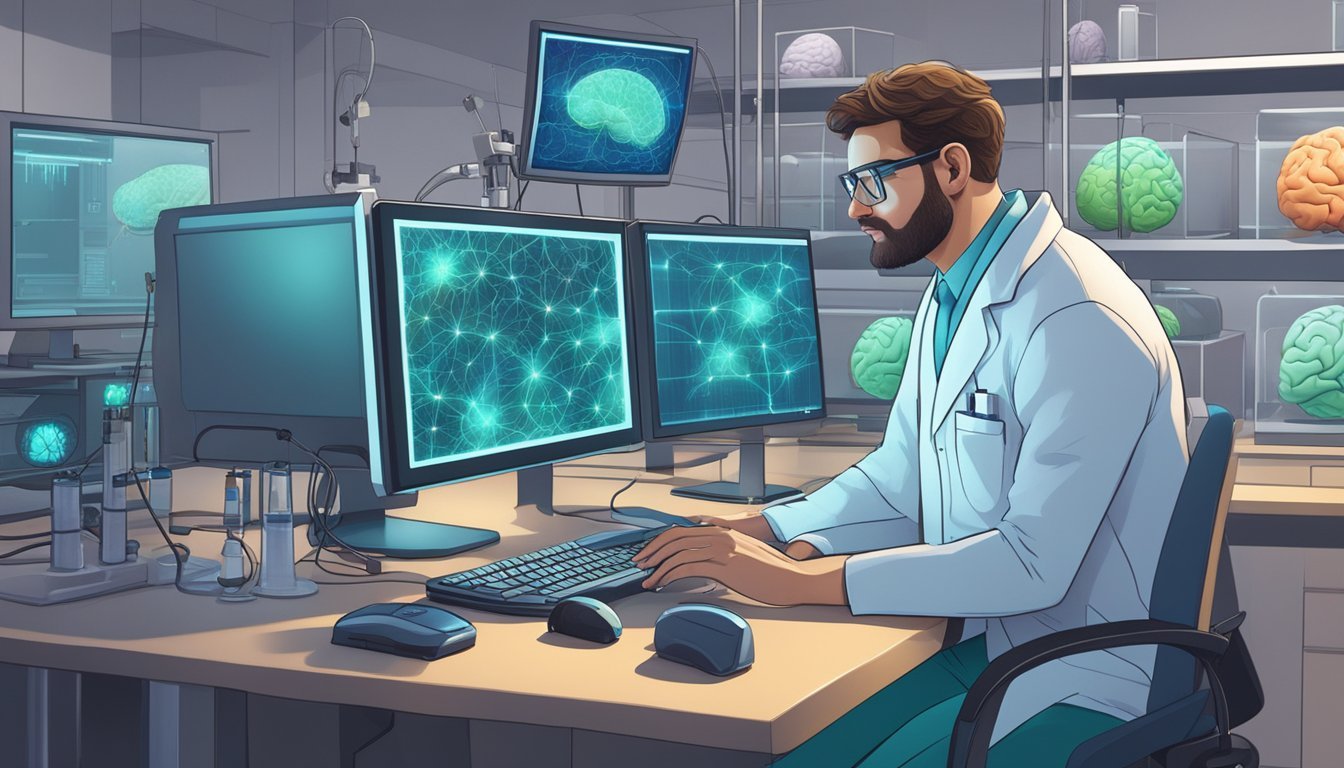Mind Control Breakthrough: Neuralink's Brain Chips Turn Thoughts into Digital Commands!
Neuralink has made significant strides in its human trials of brain-computer interface technology. The company recently implanted its device in two participants as part of its PRIME Study. These pioneering procedures mark a crucial step forward in Neuralink's mission to restore digital autonomy to individuals with quadriplegia.
The first participant received the Neuralink implant earlier this year, followed by a second participant named Alex. Both surgeries were reported as successful, with Alex being discharged from the hospital the day after the procedure. The implants aim to allow users to control devices through thought, potentially revolutionizing the lives of those with severe mobility limitations.
Neuralink's clinical trial represents a major milestone in the field of brain-computer interfaces. As the study progresses, researchers will closely monitor the participants' ability to interact with technology using only their thoughts. The outcomes of these trials could pave the way for future advancements in neurotechnology and assistive devices.
Background of Neuralink
Neuralink aims to revolutionize human-computer interaction through advanced brain-computer interfaces. The company's ambitious goals and cutting-edge technology have attracted significant attention in the neurotechnology field.
The Vision of Elon Musk
Elon Musk founded Neuralink in 2016 with a bold vision. He aims to create a symbiosis between human brains and artificial intelligence. Musk believes this technology could enhance cognitive abilities and treat neurological conditions.
Neuralink's primary focus is developing implantable brain-machine interfaces. These devices could potentially restore sensory and motor function in individuals with neurological disorders. Musk envisions future applications ranging from memory enhancement to direct neural control of devices.
The company's ambitious goals have sparked both excitement and skepticism in scientific circles. Critics question the feasibility and ethics of such advanced brain-computer interfaces.
Evolution of Neuralink's Technology
Neuralink has made significant strides in developing its brain-computer interface technology. The company's initial focus was on creating ultra-thin, flexible electrodes called "neural lace."
These electrodes are designed to be implanted in the brain with minimal invasiveness. Neuralink's implant, known as the "Link," contains thousands of electrodes capable of recording and stimulating neural activity.
Key technological advancements include:
Miniaturization of implantable components
Development of a robotic surgical system for precise electrode placement
Creation of wireless data transmission capabilities
Neuralink continues to refine its technology, aiming for higher resolution neural recording and more effective brain-computer communication.
Understanding Brain-Computer Interfaces
Brain-computer interfaces (BCIs) form the core of Neuralink's technology. These systems translate neural signals into digital commands, enabling direct communication between the brain and external devices.
BCIs typically consist of three main components:
Sensors to detect brain activity
Signal processing algorithms to interpret neural signals
Output devices that respond to the processed signals
Neuralink's approach focuses on invasive BCIs, which involve surgically implanted electrodes. This method offers higher signal quality and precision compared to non-invasive alternatives.
Potential applications of BCI technology include:
Restoring movement in paralyzed individuals
Treating neurological disorders like epilepsy or Parkinson's disease
Enhancing cognitive functions in healthy individuals
As Neuralink progresses with human trials, the scientific community eagerly anticipates new insights into the capabilities and limitations of advanced brain-computer interfaces.
Neuralink's Progress in Human Trials
Neuralink has made significant strides in its human trials, advancing from regulatory approval to successful implantations. The company's PRIME Study marks a crucial phase in developing brain-computer interface technology for clinical applications.
Ethics and Approval Process
Neuralink received FDA approval in May 2023 to commence its first-in-human clinical trial. This milestone followed extensive preparation and regulatory scrutiny. The approval process involved rigorous evaluation of safety protocols and ethical considerations.
Neuralink's approach has faced criticism from various experts. Concerns range from potential long-term effects to the pace of advancement. The company has worked to address these issues through transparency and collaboration with regulatory bodies.
The Prime Study and Patient Registry
In September 2023, Neuralink launched the PRIME Study (Precise Robotically Implanted Brain-Computer Interface). This groundbreaking trial aims to evaluate the safety and efficacy of the Neuralink implant.
The company opened a patient registry for potential participants. Criteria for inclusion focus on individuals with specific neurological conditions. Neuralink has reported successful implantations in at least two participants.
Successes and Challenges Faced
Early results from the PRIME Study show promise. The first participant, implanted over 100 days ago, has demonstrated improved ability to control computer interfaces. A second participant, Alex, underwent successful surgery and has shown progress in using computer-aided design software.
Neuralink reported a new world record for human BCI cursor control at 4.6 bits per second, later surpassed by 8 bits per second. These achievements highlight the potential of the technology.
Challenges remain in long-term efficacy and scalability. Neuralink continues to refine its technology and surgical procedures based on ongoing trial data.
The N1 Implant: A Deeper Dive
Neuralink's N1 Implant represents a significant advancement in brain-computer interface technology. This device utilizes highly sophisticated components and surgical techniques to establish a direct connection with the brain.
Implantation Surgery and the Surgical Robot
The N1 Implant is surgically placed using Neuralink's custom-designed R1 Robot. This automated system ensures precise placement of the device's 1,024 electrodes across 64 flexible threads. Each thread is thinner than a human hair, allowing for minimal tissue disruption.
The robot's advanced imaging and targeting systems guide the threads to specific brain regions. This precision is crucial for optimal neuron spike detection and signal quality. The implantation procedure aims to be minimally invasive, potentially reducing recovery time and complications.
Thread Retraction and Implant Durability
Recent reports indicate challenges with thread retraction in the first human trial. Approximately 85% of the implanted threads may have retracted or ceased functioning properly. This highlights the complexity of maintaining long-term stability in the brain environment.
Neuralink is likely addressing these durability issues in ongoing research. Factors such as brain movement, immune response, and material properties all play roles in implant longevity. Improving thread anchoring techniques and materials could enhance the device's long-term performance.
The company continues to refine the N1 Implant design to increase its durability and effectiveness. These efforts are crucial for achieving reliable, long-term brain-computer interface functionality in future trials and potential clinical applications.
Potential Applications and Benefits
Neuralink's brain-computer interface technology has the potential to revolutionize healthcare and human capabilities. The device aims to restore function for those with neurological conditions and enhance communication in unprecedented ways.
Restoring Independence for Those with Paralysis
The Neuralink implant offers hope for individuals with paralysis caused by conditions like spinal cord injuries, amyotrophic lateral sclerosis (ALS), and quadriplegia. By decoding neural signals, the device could allow patients to control external devices using their thoughts. This breakthrough may enable tasks such as typing, web browsing, and operating wheelchairs or prosthetic limbs.
Early trials have shown promising results. One participant reportedly gained the ability to move a computer cursor with their mind. This level of digital autonomy could significantly improve quality of life and independence for those with severe mobility limitations.
Advancing Communication through Telepathy
Neuralink's technology may pave the way for direct brain-to-brain communication, often referred to as "telepathy." This could transform how humans interact and share information. The implant might allow thoughts, emotions, and complex ideas to be transmitted instantly between individuals with compatible devices.
For people with speech impairments or locked-in syndrome, this technology could provide a vital lifeline. It may enable non-verbal communication at speeds and with nuances that surpass current assistive technologies.
Expanding Capabilities Beyond Disability
While initial applications focus on medical needs, Neuralink's potential extends beyond treating disabilities. The technology could enhance cognitive abilities, improve memory recall, or enable rapid learning. Users might access information directly from digital sources or control smart home devices with a mere thought.
These advancements raise both excitement and ethical questions. The ability to augment human capabilities through brain-computer interfaces could redefine the boundaries of human potential. However, careful consideration must be given to issues of privacy, security, and equitable access as this technology progresses.
User Interface and External Devices
Neuralink's brain-computer interface enables users to control various external devices through a dedicated app. This technology offers new possibilities for interfacing with computers, smartphones, and assistive devices.
Controlling External Devices with the Neuralink App
The Neuralink app serves as the primary interface for users to interact with external devices using their thoughts. Through this application, individuals can control cursors, type text, and operate robotic arms. Users have demonstrated the ability to move cursors on screens with increasing speed and accuracy. In early trials, participants achieved cursor control speeds up to 8 bits per second, approaching the typical speed of able-bodied individuals using a traditional mouse.
The app's interface is designed to be intuitive and customizable, allowing users to adapt it to their specific needs and preferences. It provides real-time feedback on brain signals and device performance, helping users improve their control over time.
Interfacing with Other Technologies
Neuralink's BCI technology is being developed to integrate with a wide range of existing and future devices. This includes smartphones, computers, and specialized assistive technologies. The system's wireless capabilities allow for seamless connectivity with compatible devices.
Researchers are exploring ways to expand the range of controllable devices, including wheelchairs, prosthetic limbs, and smart home systems. The goal is to create a versatile platform that can adapt to various technological ecosystems, enhancing users' independence and interaction with their environment.
Ongoing development focuses on improving the precision and reliability of device control, as well as expanding the types of commands that can be executed through thought alone.
Monitoring and Interpreting Neural Activity
Neuralink's brain-computer interface relies on sophisticated methods to detect and analyze neural signals. The system processes vast amounts of data to translate brain activity into actionable commands.
Detecting and Understanding Brain Signals
The N1 Implant uses 1,024 electrodes distributed across 64 flexible threads to record neural activity. These ultra-thin threads, each thinner than a human hair, are precisely placed in specific brain regions. The electrodes capture electrical signals produced by neurons firing.
Advanced algorithms filter and amplify these weak electrical impulses. Machine learning models then decode the patterns, distinguishing between different types of neural activity. This process allows the system to interpret the user's intended movements or commands.
Feedback Loop and Neural Data Analysis
Real-time analysis of neural data enables a continuous feedback loop between the user and the device. As users attempt tasks, the system provides immediate visual or tactile feedback. This allows for rapid adjustments and learning.
The N1 Implant streams neural data to external processors for complex computations. These processors identify relevant signal patterns and translate them into digital commands. Users can then control external devices or interfaces through thought alone.
Ongoing research focuses on improving signal clarity and interpretation accuracy. Scientists analyze long-term neural data trends to refine algorithms and enhance the system's responsiveness over time.
Considerations for Safety and Regulations
Neuralink's human trials face crucial safety and regulatory hurdles. The company must address neurosurgical risks and comply with stringent medical device standards to ensure patient protection.
Neurosurgical Risks and Mitigation
Neuralink's brain-computer interface implantation involves delicate neurosurgery. The procedure uses a surgical robot to insert thin, flexible threads into specific brain regions. Potential risks include bleeding, infection, and neurological damage.
To mitigate these risks, Neuralink collaborates with leading neurosurgeons and institutions like Barrow Neurological Institute. The company has developed advanced imaging and precision robotics to minimize tissue damage during implantation.
Strict sterilization protocols and post-operative monitoring are implemented to prevent infections. Neuralink also conducts extensive pre-clinical testing on animal models to refine surgical techniques and assess long-term safety.
Regulatory Compliance and Standards
Neuralink must adhere to rigorous regulatory standards for its human trials. The FDA approval process requires comprehensive safety data and risk assessments.
The company submits detailed clinical trial protocols outlining patient selection criteria, surgical procedures, and follow-up evaluations. Neuralink implements robust data management systems to track patient outcomes and device performance.
Independent ethics committees review trial designs to ensure participant rights and well-being are protected. Neuralink also establishes clear protocols for adverse event reporting and device removal if necessary.
Ongoing compliance with Good Clinical Practice guidelines is essential throughout the trials. Regular audits and inspections by regulatory bodies help maintain high safety standards and data integrity.
Patient Stories and Testimonials
Neuralink's human trials have yielded remarkable insights through firsthand accounts from participants. These stories highlight the transformative potential of brain-computer interface technology in improving lives.
Living with an N1 Implant
Noland Arbaugh, a quadriplegic and the first patient in Neuralink's PRIME Study, has shared his experience with the N1 implant. After the implantation surgery, Arbaugh gained the ability to control a computer cursor using only his thoughts. He can now play video games, including Mario Kart on the Nintendo Switch, demonstrating the device's responsiveness.
Arbaugh describes the sensation as "constantly multitasking" with his brain. The implant allows him to perform multiple actions simultaneously, a stark contrast to his previous limitations. He emphasizes the seamless integration of the technology into his daily life.
The Impact on Quality of Life
The N1 implant has significantly enhanced Arbaugh's independence. He can now use computer-aided design (CAD) software, opening up new possibilities for creative expression and potential career opportunities. This increased autonomy has positively affected his mental well-being and sense of self-sufficiency.
Arbaugh's ability to communicate and interact with technology more efficiently has improved his social connections. He can participate in live streams and engage with others online more easily. The implant has also simplified basic tasks, reducing his reliance on caregivers for certain activities.
While challenges remain, Arbaugh's story illustrates the potential of Neuralink's technology to enhance the quality of life for individuals with severe mobility limitations.




